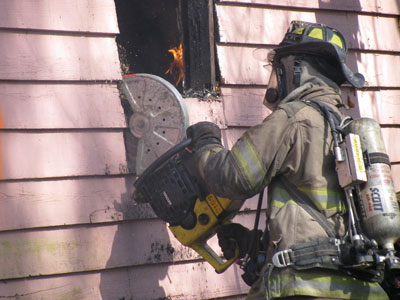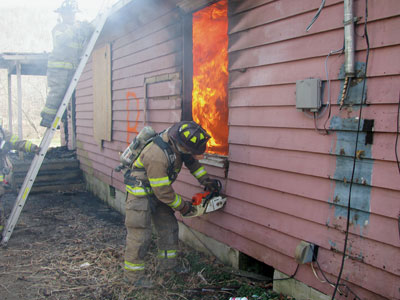
Features
Structural
Training
Attack strategy
As I sit and listen for the 100th time to the recording of the Toronto Fire Services response to the hoarding fire on the 20th floor of 200 Wellesley St. in September 2010, one thing stands out: firefighters could not attack from the sides.
April 23, 2013
By Ryan Pennington
As I sit and listen for the 100th time to the recording of the Toronto Fire Services response to the hoarding fire on the 20th floor of 200 Wellesley St. in September 2010, one thing stands out: firefighters could not attack from the sides.

|
|
| In hoarding or heavy content conditions, primary entrances and exits may be blocked by belongings and firefighters may have to make a window into a door to gain access. Photos by Jonathan Coleman, Pinch Fire Department, West Virginia
|
Over the past two years, during which I have taken on the topic of fighting fires in hoarding conditions, one glaring similarity comes out every time I reach out to a fire department to learn from its experiences: the firefighters attacked from the sides. In the case of Wellesley Street – which was the worst hoarding fire in Canada – firefighters simply could not access the unit of origin from the sides given its location on an upper floor of the building. (See the December 2010 issue of Fire Fighting in Canada and the October 2011 issue of Canadian Firefighter and EMS Quarterly – at www.firefightingincanada.com – for more on the Wellesley Street fire.)
Attacking from the sides offers firefighters a safer environment, provides for more entry and exit points, and allows firefighters to make an assessment of the interior conditions before committing firefighters to the interior. Let’s take a look at this common attack strategy when it comes to dealing with fires in hoarding conditions.
Since the days of Homer and Langley Collyer in Manhattan – they were the first real documented hoarders, eccentric brothers who were found dead in March 1947 among the 140 tons of collected items in their Harlem home – the fire service has been dealing with the problem and challenges of hoarding. The reach of this disorder is being felt worldwide. Compulsive hoarding disorder crosses all borders, races, and income levels. It can affect people in your district the same as it did in Manhattan in the 1940s. One advantage today is the availability of information; a new awareness of this problem has been brought to the world by television shows that document the struggles of people who are affected by hoarding.
Safer environments
Using your size-up skills to identify hoarding conditions can and should influence a first-arriving officer’s tactical decisions. Cues and clues such as cluttered front yards, blocked windows and doorways, collections of belongings in the backyards, and piles of debris inside vehicles can help to establish that you are facing hoarding conditions, or heavy-content environments.
 |
|
| Performing a windowsill removal in a hoarding situation gives firefighters a point of entry to make a push to the seat of the fire, and provides an exit for trapped occupants. |
Using the term heavy content indicates numerous things to the crews on scene and those responding to the fire. First, it will put everyone in a defensive mindset since they understand that the structure is overloaded and at risk of collapse before the first drop of water is sprayed. Second, it is a politically correct way of sharing the message that hoarding conditions are present.
Patients with compulsive hoarding disorder have deeply rooted emotional connections to belongings that have no apparent value to you and me; being respectful and mindful of their situations is an important precaution, as it has been documented that the deep compulsion can lead to a psychiatric emergency if the terms hoarder or hoarding are used. Terms such as pack rat or trash house are even worse.
Once you have discovered heavy content, and before committing crews to the interior, you should consider a few safety observations that can be made from the outside. If you can access the room of involvement and quickly knock down the fire, you may be able to use the reduction in air flow to your advantage. Darkening down the fire from the outside is a highly controversial and often-debated tactic that needs to be used when dealing with heavy-content fires. Ironically, this tactic will need to be adjusted if you receive a report of occupants trapped inside, as the steam that may increase the effectiveness of your side attack may just as easily eliminate their potential for survival.
Allow for more entry and exit points
Another common characteristic of hoarding conditions is the multiple blocked means of entry and egress. As the collection of belongings begins to take over the home, windows, doorways and stairwells will become blocked, creating challenges to exiting occupants and entering firefighters. These challenges can be overwhelming, especially to firefighters trying to make a rescue or advance on the fire.
In hoarding conditions, occupants may no longer use the primary front and back doors for entry, as these may be blocked by belongings.
Multiple cases have been documented in which occupants have used windows, garage doors, and even portable ladders to make entry into their cluttered world. The right point of entry for firefighters may not be the front or rear door; it may be necessary to make a window into a doorway to access the heavily cluttered interior. Performing this windowsill removal and beginning to pull belongings out of the way can serve two purposes: it can allow firefighters access inside, to make a push toward the perceived seat of the fire; and it can allow occupants or firefighters entering the house another way out if the conditions deteriorate. That said, opening these exterior points allows for increased horizontal ventilation and should never be done behind an advancing crew. Any task that can allow a sudden rush of air should be co-ordinated with command and interior crews.
Allow an interior assessment
Upon arriving at a reported structure fire, first-arriving command always does a 360- degree size-up. Noticing cluttered conditions, the officer should add another 20 degrees and look inside the occupant’s vehicle to identify possible hoarding conditions. While this practice is not proven, it can raise a level of suspicion that a heavy-content environment is present. Another benefit of this 380-degree size-up and attacking from the side is the ability to assess how bad the hoarding conditions are in the interior. This assessment can lead to the decision to make a push on the interior or remain on the exterior and choose a defensive operation from the beginning.
Once there is suspicion of a hoarding situation, firefighters, commanders, and company offers should use a scale to rate the severity of hoarding. This scale should be on a one to five level, with five being a no-entry fire. This scale can help officers to determine the point at which the risk of interior attack is too high. For example, if there is more than one blocked means of entry, and belongings are stacked to the ceiling in more than one room, you would assign a value of five on the scale. This would automatically set the operation to a defensive mode and limit the attempts at rescue, as the risk-a-lot-to-save-a-life principle may not be applicable because of the extreme risk, and could be the hardest decision that fire-ground officers have to make. Using the scale should not overtake logical fire-ground size-up but should supplement it to identify the challenging environment when hoarding is found.
Attack strategies
Now that you have determined that a heavy-content environment is present, you have removed one or more windowsills, it’s time to go in or stay out. This decision should be based on the above considerations; let’s start with every firefighter’s favourite – interior attack. If you have chosen to make an interior push from the sides, you should be prepared for the battle ahead. Heavy-content environments offer many challenges that crews should be expecting. From falling debris to narrowed goat paths, interior crew size needs to be increased from the traditional one or two firefighters to help deal with the added workload. When advancing on the fire, interior crews should always be looking out for the increased chance of flashover or backdraft depending on the compression of belongings.
Defensive attack is another, safer, strategy used when dealing with heavy-content fires. While a defensive attack is often less favoured by firefighters, in heavy-content environments it should be at the forefront of the firefighting strategy. Once you choose to attack from the outside using the sides, you will need to set up master streams and handlines in positions so that you can direct streams above the hoarding level. Trying to penetrate deeply inside a pile of belongings this big can be challenging. By directing hose streams above the belongings, you will allow the water to absorb the heat and rain down on the most likely part that is burning, the top layer. Think of a rolled up newspaper: does the middle burn or does the outside layer? The main safety consideration for this attack is the need to remain outside the collapse zone.
Staying back 1.5 times the height of the building will reduce the chance of firefighters being hurt or killed if the structure fails.
Hoarding fires are not normal bread-and-butter fires; they are complex fires with multiple variables that need consideration before attack strategies are determined. Not committing your firefighters to the interior when hoarding conditions are present will bring your firefighters home safely. Can an interior attack be made in heavy hoarding conditions? Yes. But attacking from the sides may be the wiser decision to ensure that everyone goes home.

|
|
Ryan Pennington is a firefighter/paramedic for the Charleston Fire Department in Charleston, W.V. He is assigned to Station 8 and is part of the West Virginia Task Force 1 USAR team. Ryan has more than 15 years of combined fire, rescue and EMS experience. He started with a local volunteer department and continued through EMS to spend five years as a critical care paramedic. Ryan transferred to the career fire service in 2003 and has worked for the City of Charleston since 2007. He is currently a WV State Instructor 2, a hazmat technician, and a certified Fire Officer 2. He is very involved teaching EMS and firefighter safety across North America.
Print this page